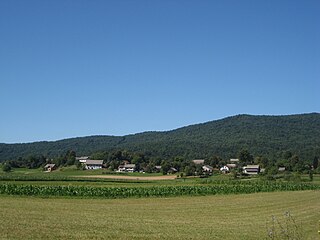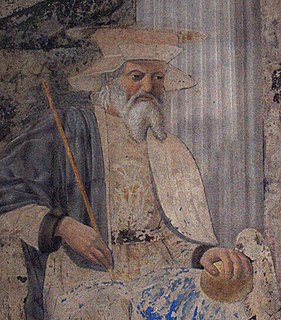
Cerov Log is a small settlement in the Gorjanci Hills in the Municipality of Šentjernej in southeastern Slovenia. Its territory extends right to the border with Croatia. The area was traditionally part of Lower Carniola. It is now included in the Southeast Slovenia Statistical Region.

Čadraže is a village on the right bank of the Krka River in the Municipality of Šentjernej in southeastern Slovenia. The area was traditionally part of Lower Carniola. It is now included in the Southeast Slovenia Statistical Region.

Dolenja Stara Vas is a settlement immediately southeast of the town of Šentjernej in southeastern Slovenia. The area was traditionally part of Lower Carniola. It is now included in the Southeast Slovenia Statistical Region. The village belongs to the Village Community of Grmovlje.

Dolenje Mokro Polje is a settlement in the Municipality of Šentjernej in southeastern Slovenia. The area was traditionally part of Lower Carniola. It is now included in the Southeast Slovenia Statistical Region. The village was first mentioned in 1227 as Unter Nassenfeld. Due to flooding, the villagers began to settle at a nearby location, where it still stands. Only a few ruins have survived at the old location. According to the 2003 census, there are 36 houses in the village. Villagers attend Saint Sigismund's Church in the neighboring village of Polhovica.

Drama is a village in the Municipality of Šentjernej in southeastern Slovenia. The area was traditionally part of Lower Carniola. It is now included in the Southeast Slovenia Statistical Region. It includes the hamlets of Dolenja Gomila, formerly an independent settlement, to the west and Otok to the northwest.

Drča is a village in the foothills of the Gorjanci Hills in the Municipality of Šentjernej in southeastern Slovenia. The area was traditionally part of Lower Carniola. It is now included in the Southeast Slovenia Statistical Region.

Gorenja Stara Vas is a village in the Municipality of Šentjernej in southeastern Slovenia. The area was traditionally part of Lower Carniola. It is now included in the Southeast Slovenia Statistical Region.

Gorenje Mokro Polje is a settlement west of Šentjernej in southeastern Slovenia. The area was traditionally part of Lower Carniola. It is now included in the Southeast Slovenia Statistical Region.

Gorenje Vrhpolje is a settlement southwest of Šentjernej in southeastern Slovenia. The area was traditionally part of Lower Carniola. It is now included in the Southeast Slovenia Statistical Region.

Groblje pri Prekopi is a settlement northeast of Šentjernej in southeastern Slovenia. The area was traditionally part of Lower Carniola. It is now included in the Southeast Slovenia Statistical Region.

Hrastje is a small settlement in the foothills of the Gorjanci Hills in the Municipality of Šentjernej in southeastern Slovenia. The area was traditionally part of Lower Carniola. It is now included in the Southeast Slovenia Statistical Region.

Ledeča Vas is a village east of Šentjernej, at the foot of the Gorjanci Hills in southeastern Slovenia. The area was traditionally part of Lower Carniola. It is now included in the Southeast Slovenia Statistical Region.

Mihovica is a settlement on the right bank of the Krka River in the Municipality of Šentjernej in southeastern Slovenia. Traditional 19th-century farmhouses and outbuildings are preserved in the village core and it has been included on the Slovenian Ministry of Culture's register of national heritage. The area was traditionally part of Lower Carniola. It is now included in the Southeast Slovenia Statistical Region.

Ostrog is a small village north of Dolnja Prekopa in the Municipality of Šentjernej in southeastern Slovenia. Its territory extends north of the main settlement to the banks of the Krka River. The entire municipality was traditionally part of Lower Carniola. It is now included in the Southeast Slovenia Statistical Region.

Rakovnik is a small settlement in the Municipality of Šentjernej in southeastern Slovenia. It lies in the foothills of the Gorjanci range. The entire municipality was traditionally part of Lower Carniola. It is now included in the Southeast Slovenia Statistical Region.

Šmarje is a settlement in the Municipality of Šentjernej in southeastern Slovenia. It was traditionally part of Lower Carniola and is now included in the Southeast Slovenia Statistical Region.

Tolsti Vrh is a settlement in the foothills of the Žumberak/Gorjanci range in the Municipality of Šentjernej in southeastern Slovenia. It was traditionally part of Lower Carniola and is now included in the Southeast Slovenia Statistical Region.

Hrast pri Vinici is a village north of Vinica in the Municipality of Črnomelj in the White Carniola area of southeastern Slovenia. The area is part of the traditional region of Lower Carniola and is now included in the Southeast Slovenia Statistical Region.

Nova Lipa is a village northwest of Vinica in the Municipality of Črnomelj in the White Carniola area of southeastern Slovenia. The area is part of the traditional region of Lower Carniola and is now included in the Southeast Slovenia Statistical Region.











